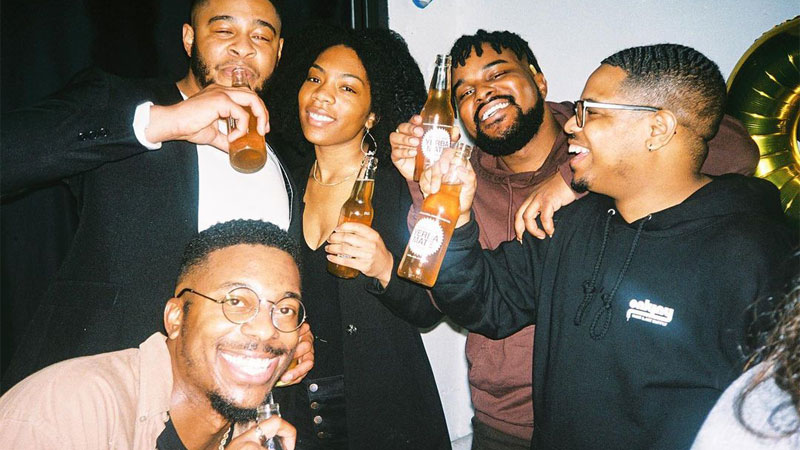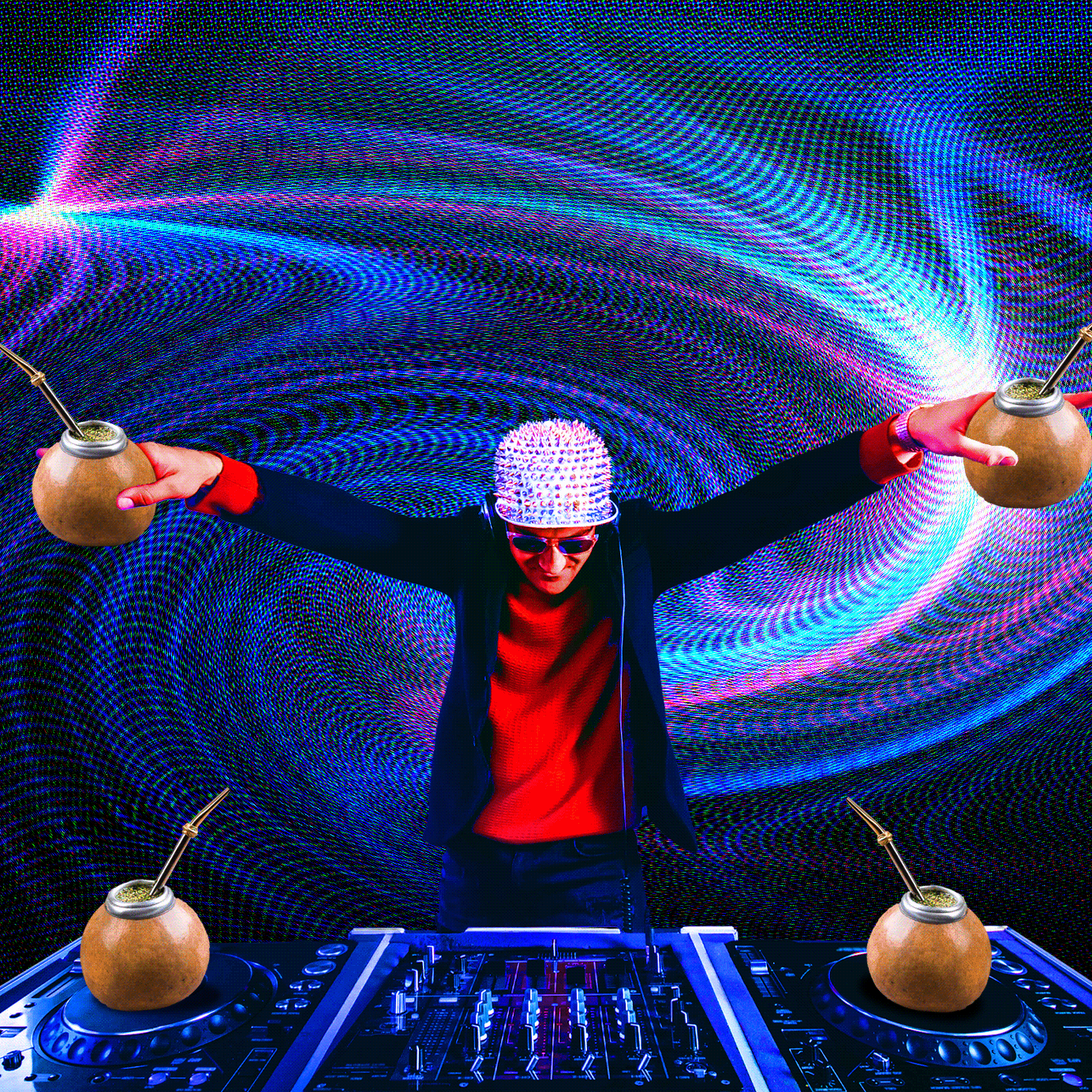Do you feel it? The not-so-subtle shift? It has people spending $400 at upscale supermarket chain Erewhon and supermodels creating non-alcoholic, functional beverages. Culture has been building steadily toward “healthy lifestyles” being in vogue and nightlife is far from immune. There are more mocktails, juice options, and non-alcoholic beers than ever before. A new party at the East Village’s Joyface, billed as a “nighttime disco for millenials,” runs from 5 to 10 p.m., allowing partiers to be asleep before midnight. In some less wholesome spaces, ketamine has eclipsed cocaine’s long-term popularity, replacing the stimulant with a drug used for therapizing PTSD. At the center of it all is a Brooklyn raver go-to cocktail: tequila-spiked yerba mate.
Unlike a Long Island Iced Tea, Tequila Mate does, in fact, contain tea. It has roughly the same caffeine level as a standard cup of coffee and keeps clubgoers on the dance floor until the lights come on. Is this cocktail’s rising popularity the solution to finding a healthier way to rage? Or is it just a Vodka Red Bull in disguise?
From Ritual to Raves
Yerba mate is a plant indigenous to South America. The leaves are dried, ground, steeped, and usually used for medicine or social rituals. Predictably, mate was taken by another continent and adapted to its culture, with Germany being the origin of mate’s modern club popularity.
In 1924, a small beverage company in Northern Bavaria made raver history by bottling what would eventually become the celebrated Club-Mate brand. Loscher, a local brewery, purchased the license to make the drink in the early 1990s, gave it its name, and eventually sent bottles to Berlin and Hamburg. Computer hackers were the first to adopt the beverage as a more mellow approach to staying awake all night, and the ravers weren’t far behind. As the Berlin electronic music scene surged, perfectly timed with the East’s culture boom following the fall of the Berlin Wall, Club-Mate became a nightlife staple.
Mate wasn’t fully introduced to the U.S. until a hacker convention in 2008, but it can now be found in many bodegas throughout New York City, as well as grocery stores and specialty health food stores. However, it’s the clubs in Brooklyn that championed its use in cocktails; most of the city’s raves and clubs reside in the borough, as well as a community with a penchant for being health-conscious.
Nowadays, a club on the border of Bushwick and Ridgewood, will go through three to five cases a night, even more on Nonstop weekends, a weekly event that runs from 11 p.m. on Saturday to Sunday night and sometimes even Monday morning. The club stocks Brooklyn’s own version of Club-Mate, White Label, a carbonated yerba mate soda brewed locally and founded by nightlife community pillar John Barclay and his partners. Barclay owns Bossa Nova Civic Club, another Brooklyn dance mainstay.
Valera Urena has worked at Good Room in Greenpoint for six years and says Tequila Mate is in the top five of most ordered drinks. “It depends on the party, but it’s definitely popular with the techno crowd,” Urena says, “It’s really a Brooklyn thing.”
Brooklynite Nate Brown is a member of this crowd and frequents raves on a regular basis. “Raves are almost like a form of exercise,” he says, “and it’s a marathon, not a sprint.” Techno and surrounding rave culture differs greatly from a typical bottle service club. In general, attendees aren’t looking to get wasted, but rather to maintain their energy until they’ve seen the DJs they came for, often well into the daylight. “If you wanna make it through, it’s about sustaining,” Brown says, “I tend to not drink as much because that can wipe you out earlier.”
A Gift From the Rave Gods
Since yerba mate exists in the tea family, it brings with it many of the beverage’s classic benefits. “Most tea has antioxidants which are great for lowering inflammation,” says Nicole Sohayegh, a certified dietitian nutritionist of New York City Nutrition. “There’s also the potential for yerba mate to lower cholesterol.” According to WebMD, it can help with weight loss, disease prevention, various mental disorders, and even, ironically, substance abuse.
Indigenous to South America, mate was considered “a gift from the gods,” simply because of its health benefits. There may be some individuals who would give Red Bull the same honor, but they would more likely be people into extreme sports, not medical professionals. “It’s more highly processed,” Sohayegh says. “And if you’re not drinking the sugar-free, it’s a lot more sugar.”

Various spirits are known to mix well with yerba mate, though vodka and tequila prevail as frontrunners, with tequila in the lead. “First you get the energy from the mate and I find tequila to also be a bit of an energizer,” Brown says. “It tastes good and it’s not going to make you a zombie like drinking a ton of beer. That’s why I gravitate towards it.”
Before yerba mate came on the scene, Red Bull owned the caffeinated club cocktail market. The Vodka Red Bull was allegedly invented at the San Francisco bar Butter, and has retained a level of nightlife popularity after its 1990s boom. There is, without a doubt, a cultural difference between the two drinks. One could absolutely argue that the Vodka Red Bull has gone out of style — that it’s out of place and an unlikely order. A Vodka Red Bull feels like a sweaty guy who’s talking too loud, while a Tequila Mate is a levelheaded music expert who’s there for the vibes. (For those interested, an Espresso Martini feels like a social media manager discussing juicy workplace drama.)
The Risk of the Caffeinated Cocktail
There’s been a widespread dissemination of facts warning against the dangers of mixing caffeine and alcohol, most recently a TikTok with over 3 million views. User @kailchipp recorded a video from a hospital bed urging her viewers to “Stop drinking Vodka Red Bulls! Do not drink more than 10 energy drinks in a 24 hour period, you will have a heart attack<3”
This may seem obvious, as the recommended daily intake of caffeine is 400 milligrams. “About four cups of coffee,” Sohayegh explains, though people often consume more. “Someone could easily drink four Espresso Martinis at night after having two or three cups of coffee during the day.”
And yet, like the Espresso Martini, Tequila Mate has avoided the vilification that other caffeinated alcoholic beverages have endured. Just ask Vodka Red Bull’s kooky cousin, Four Loko. Debuting in 2005, the 23.5-ounce can of malt liquor contained 12 percent ABV and 156 milligrams of caffeine, which translates to roughly four beers and two Red Bulls. By November 2010 it was banned following hospitalizations of its most popular demographic, the under-21 crowd. While the name lives on, present-day Four Loko is free of caffeine.
“The healthiest way to have a cocktail is just liquor and club soda with only a lemon or lime. It’s a natural substance without a huge amount of caffeine.”
What exactly makes mixing alcohol and caffeine dangerous?
“Masking,” Sohayegh explains, adding “caffeine is a diuretic so it masks the effects of alcohol encouraging you to drink past your normal limit.” The effects of alcohol are still present, however, making it easier to blackout or act incoherently, even if caffeine makes the drinker feel alert. TikTok user @kailchipp is shown wide awake in her viral post following 10 Vodka Red Bulls, but 10 Vodka Sodas likely would have been a very different story.
Combining alcohol (a depressant) and caffeine (a stimulant) confuses the nervous system, according to Sohayegh. There are myths and theories that tempt these facts, but Sohayegh busts them all. Drinking coffee or another form of caffeine will not, unfortunately, sober you up, and while tequila may produce a burst of energy, it is, like all alcohol, a depressant.
So where does that leave the Tequila Mate? Is it the savior of the health-conscious clubgoer?
“The healthiest way to have a cocktail is just liquor and club soda with only a lemon or lime,” Sohayegh says, though a Tequila Mate is definitely preferable health-wise to a Vodka Red Bull and even an Espresso Martini. “It’s a natural substance without a huge amount of caffeine,” she says.
Wine could be a resourceful substitute, especially with natural wine’s growing popularity at clubs; like mate, it has some credible health benefits, but with alcohol in place of the caffeine. Sohayegh also recommends drinking water between each alcoholic drink for pacing and hydration. Ultimately, Tequila Mate is the hot yoga of club cocktails; it’s ancient, health conscious, a bit trendy, and will leave you dehydrated.
